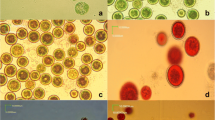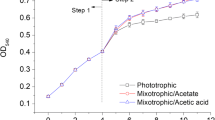Abstract
During light induction for astaxanthin formation in Haematococcus pluvialis, we substituted photoautotrophic induction for heterotrophic induction using acetate, both to prevent contamination by heterotrophs due to addition of organic carbon and to enhance carbon assimilation in the induced cells. Strong photoautotrophic induction was performed by N-deprivation of photoautotrophically grown Haematococcus cells followed by supplementation with bicarbonate (HCO3−) or CO2. Bicarbonate-induced cells contained more astaxanthin than acetate-induced cells, and even further enhancement of astaxanthin accumulation was achieved by continuous CO2 supply. The maximum astaxanthin content (77.2 mg g−1 biomass, 3.4-fold higher than with heterotrophic induction) was obtained under conditions of 5% CO2, yielding astaxanthin concentration and productivity of 175.7 mg l−1 and 6.25 mg l−1 day−1, respectively. The results indicate that photoautotrophic induction is more effective than heterotrophic induction for astaxanthin synthesis in H. pluvialis.



Similar content being viewed by others
References
Boussiba S (2000) Carotenogenesis in the green alga Haematococcus pluvialis: cellular physiology and stress response. Physiol Plant 108:111–117
Boussiba S, Vonshak A (1991) Astaxanthin accumulation in the green alga Haematococcus pluvialis. Plant Cell Physiol 32:1077–1082
Droop MR (1955) Carotenogenesis in Haematococcus pluvialis. Nature 175:42
Fabregas J, Dominguez A, Alvareza DC, Lamela T, Otero A (1998) Induction of astaxanthin accumulation by nitrogen and magnesium deficiencies in Haematococcus pluvialis. Biotechnol Lett 20:623–626
Fabregas J, Otero A, Maseda A, Dominguez A (2001) Two stage cultures for the production of astaxanthin from Haematococcus pluvialis. J Biotechnol 89:65–71
Fabregas J, Dominguez A, Maseda A, Otero A (2003) Interactions between irradiance and nutrient availability during astaxanthin accumulation and degradation in Haematococcus pluvialis. Appl Microbiol Biotechnol 61:545–551
Guerin M, Huntley ME, Olaizola M (2003) Haematococcus astaxanthin; applications for human health and nutrition. Trends Biotechnol 21:210–216
Harker M, Tsavalos AJ, Young AJ (1996) Autotrophic growth and carotenoid production of Haematococcus pluvialis in a 30 liter air-lift photobioreactor. J Ferment Bioeng 82:113–118
Hata N, Ogbonna JC, Hasegawa Y, Taroda H, Tanaka H (2001) Production of astaxanthin by Haematococcus pluvialis in a sequential heterotrophic–photoautotrophic culture. J Appl Phycol 13:395–402
Kakizono T, Kobayashi M, Nagai S (1992) Effect of carbon/nitrogen ratio on encystment accompanied with astaxanthin formation in a green alga, Haematococcus pluvialis. J Ferment Bioeng 74:403–405
Kaplan A, Reinhold L (1999) CO2 concentrating mechanism in photosynthetic microorganisms. Annu Rev Plant Physiol Plant Mol Biol 50:539–570
Kobayashi M, Sakamoto Y (1999) Singlet oxygen quenching ability of astaxanthin esters from the green alga Haematococcus pluvialis. Biotechnol Lett 21:265–269
Kobayashi M, Kakizono T, Nagai S (1991) Astaxanthin production by a green alga, Haematococcus pluvialis accompanied with morphological changes in acetate media. J Ferment Bioeng 71:335–339
Kobayashi M, Kakizono T, Nagai S (1993) Enhanced carotenoids biosynthesis by oxidative stress in acetate induced cyst cells of a green unicellular alga, Haematococcus pluvialis. Appl Environ Microbiol 59:867–873
Kobayashi M, Kurimura Y, Tsuji Y (1997) Light independent, astaxanthin production by the green microalga Haematococcus pluvialis under salt stress. Biotechnol Lett 19:507–509
Margalith PZ (1999) Production of ketocarotenoids by microalgae. Appl Microbiol Biotechnol 51:431–438
Olaizola M (2000) Commercial production of astaxanthin from Haematococcus pluvialis using 25,000-liter outdoor photobioreactors. J Appl Phycol 12:499–506
Orosa M, Franqueira D, Cid A, Abalde J (2001) Carotenoid accumulation in Haematococcus pluvialis in mixotrophic growth. Biotechnol Lett 23:373–378
Sarada R, Tripathi U, Ravishankar GA (2002) Influence of stress on astaxanthin production in Haematococcus pluvialis grown under different culture conditions. Process Biochem 37:623–627
Wang B, Zarka A (2003) Astaxanthin accumulation in Haematococcus pluvialis (Chlorophyceae) as an active protective process under high irradiance. J Phycol 39:1116–1124
Wellburn AR (1994) The spectral determination of chlorophylls a and b, as well as total carotenoids, using various solvents with spectrophotometers of different resolution. J Plant Physiol 144:307–313
Yuan JP, Chen F (1998) Chromatographic separation and purification of trans-astaxanthin from the extracts of Haematococcus pluvialis. J Agric Food Chem 46:3371–3375
Yuan JP, Chen F (2000) Purification of trans-astaxanthin from a high-yielding astaxanthin ester-producing strain of the microalga Haematococcus pluvialis. Food Chem 68:443–448
Acknowledgement
This research was performed for the Carbon Dioxide Reduction and Sequestration Center, one of the 21st century Frontier R&D programs funded by the Ministry of Science and Technology of Korea.
Author information
Authors and Affiliations
Corresponding author
Rights and permissions
About this article
Cite this article
Kang, C.D., Lee, J.S., Park, T.H. et al. Comparison of heterotrophic and photoautotrophic induction on astaxanthin production by Haematococcus pluvialis. Appl Microbiol Biotechnol 68, 237–241 (2005). https://doi.org/10.1007/s00253-005-1889-2
Received:
Revised:
Accepted:
Published:
Issue Date:
DOI: https://doi.org/10.1007/s00253-005-1889-2




